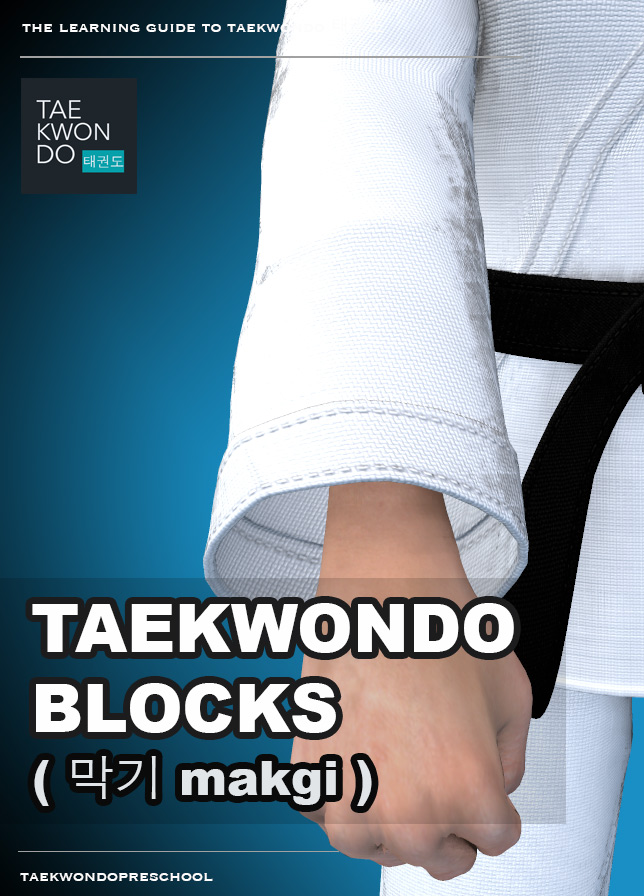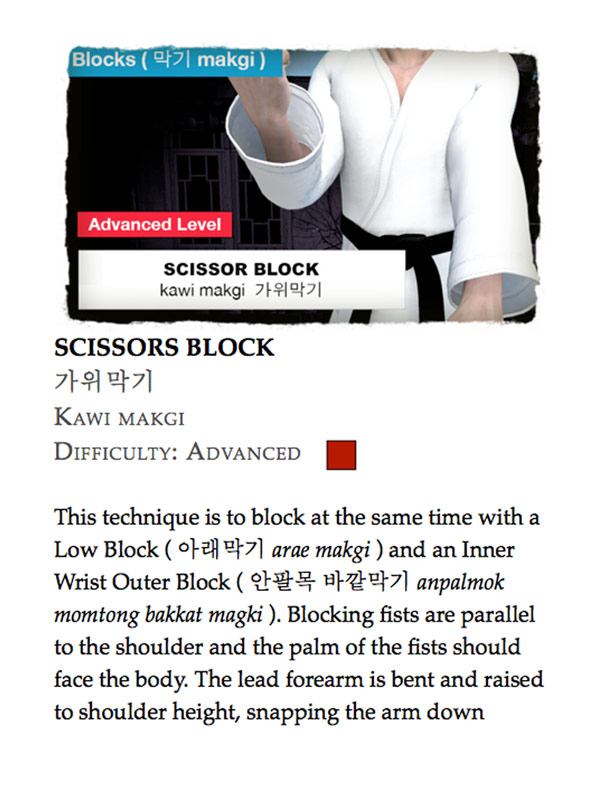- Apple Books
- Taekwondo Blocks ( 막기 makgi )
Taekwondo 태권도Taekwondo Preschool
If you have any questions about Taekwondo 태권도 or any suggestions for Taekwondo Preschool, we'd like to hear from you. For frequently asked questions visit our Support section for some answers or please feel free to Contact Us ».



Taekwondo Blocks
( 막기 makgi )
In martial arts, blocking ( 막기 makgi ) is the act of stopping or deflecting an opponent's attack for the purpose of preventing injurious contact with the body. A block usually consists of placing a limb across the line of the attack. Blocks are considered by some to be the most direct and least subtle of defensive techniques.
Taekwondo Blocks ( 막기 makgi )
This book is available for download with Apple Books on your Mac or iOS device, and with iTunes on your computer. Books can be read with Apple Books on your Mac or iOS device.


Advertisement

Quiz
Question. What is the korean terminology for Elbow Target Strike?
The Elbow Target Strike is a technique that requires you to strike an imaginary target made by extending the other arm. The elbow hits the Palm ( 손바닥 sonbadak ) of the other arm and the height is around the solar plexus. In self-defense ( 호신술 hosinsool ) applications, the practitioner would reach out and grab the opponents neck ( 목 mok ).
Question. What is the korean terminology for Elbow Target Strike?
Answer you gave was: ( 표적지르기 pyojeok-jireugi )
Your answer is wrong! You need to study more!

Target Punch ( 표적지르기 pyojeok-jireugi ) is an advanced technique that requires you to strike an imaginary target made with the palm ( 손바닥 sonbadak ) of one hand with a punch ( 지르기 jireugi ). The strike ( 지르기 jireugi ) is useful for self-defense ( 호신술 hosinsool ) applications. The technique is used in the 1st Dan Black Belt Poomse ( 품새 고려 koryo ) in a Horse-Riding Stance ( 주춤서기 juchum-sogi ).
Question. What is the korean terminology for Elbow Target Strike?
Answer you gave was: ( 등주먹 앞치기 deung-jumeok-ap-chigi )
Your answer is wrong! You need to study more!

Back Knuckle Forward Strike ( 등주먹 앞치기 deung-jumeok-ap-chigi ) is an intermediate technique striking with the back knuckle ( 등주먹 deung-jumeok ). The fist should pass over from the opposite waist to the armpit, to the chin level and then hitting with the back of the fist to the opponent's face. Focus on the tightening of the muscles of the hand while you clench a fist ( 주먹 jumeok ). If the wrist ( 팔목 palmok ) bends on impact, it can easily be sprained, dislocated or broken.
View Back Knuckle Forward Strike ( 등주먹 앞치기 deung-jumeok-ap-chigi ) »
Question. What is the korean terminology for Elbow Target Strike?
Answer you gave was: ( 팔굽 표적치기 palgup-pyojeok-chigi )
Your answer is correct! Great Job!

The elbow ( 팔굽 palgup ) hits the Palm ( 손바닥 sonbadak ) of the other arm and the height is around the solar plexus. In self-defense, the practitioner would reach out and grab the opponents neck ( 목 mok ). When pulling forward the opponents neck, the practitioner would perform an elbow strike to the opponents face ( 얼굴 eolgul ) striking directly to the nose ( 코 ko ) or eyes ( 눈 nun ) as suitable targets.
Question. What is the korean terminology for Elbow Target Strike?
Answer you gave was: ( 바깥막기 momtong-bakkat-makgi )
Your answer is wrong! You need to study more!

An Outside Middle Block ( 바깥막기 momtong-bakkat-makgi ) deflects a strike away from the defender leaving an opportunity for a counterattack. For example, against a straight punch to the chest area, the block would aim to meet the forearm of the attacker, pushing the punch outwards causing it to miss, and then most commonly leaving the defender slightly to the side to counterattack the opponent.
Question. What is the name of Taegeuk #6 in Korean?
Taegeuk 태극 (in World Taekwondo (WT)) refers to a set of poomse 품새 used to create a foundation for the teaching of taekwondo. A poomse or form is a detailed pattern of defense-and-attack motions and techniques used in traditional martial arts. Each taegeuk form symbolizes a specific state thought to be indicative of the belt the student currently holds, and is represented in World Taekwondo (WT) by trigrams similar to those found in the four corners of the South Korean flag.
Question. What is the name of Taegeuk #6 in Korean?
Answer you gave was: Yuk Jang
Your answer is correct! Great Job!


The trigram associated with this poomse represents Water. Also, there is a relation to West and the relationship with a Second son. The movements of this poomse are intended to be performed like water; flowing, powerful and cleansing. Sometimes standing still like water in a lake, sometimes thriving as a river, sometimes powerful like a waterfall.
Question. What is the name of Taegeuk #6 in Korean?
Answer you gave was: O Jang
Your answer is wrong! You need to study more!


The trigram associated with this poomse represents Wind. The trigram is also related to southwest and the relationship with an eldest daughter. The I Ching promotes that wind is a gentle force, but can sometimes be furious, destroying everything in its path. As such, it is intended that this poomse is performed like the wind: gently, but knowing the ability of mass destruction with a single movement.
Question. What is the name of Taegeuk #6 in Korean?
Answer you gave was: Sa Jang
Your answer is wrong! You need to study more!


This trigram represents Thunder. Also, the trigram is strongly connected to northeast and the relationship of the Eldest son. Thunder comes from the sky and is absorbed by the earth, thus, according to the beliefs of the I Ching, thunder is one of the most powerful natural forces. This poomse is associated with power and the connection between the heavens and earth.
Question. What is the name of Taegeuk #6 in Korean?
Answer you gave was: Chil Jang
Your answer is wrong! You need to study more!


The trigram associated with this poomse represents a Mountain. Also, it represents the northwest and youngest son. The symbolism behind the mountain is the indomitable and majestic nature that all mountains possess. This poomse is intended to be performed with the feeling that all movements are this majestic due to their unconquerable nature.
Question. What is the name of Taegeuk #8 in Korean?
The trigram associated with this poomse represents the Earth. Also, there is a representation of North and Mother. The associated trigram of this poomse is Yin. Yin, here, represents the end of the beginning, the evil part of all that is good. This being the last of the poomse Taegeuk, it represents the end of the circle and the cyclic nature of the Earth.
Question. What is the name of Taegeuk #8 in Korean?
Answer you gave was: Chil Jang
Your answer is wrong! You need to study more!


The trigram associated with this poomse represents a Mountain. Also, it represents the northwest and youngest son. The symbolism behind the mountain is the indomitable and majestic nature that all mountains possess. This poomse is intended to be performed with the feeling that all movements are this majestic due to their unconquerable nature.
Question. What is the name of Taegeuk #8 in Korean?
Answer you gave was: Yuk Jang
Your answer is wrong! You need to study more!


The trigram associated with this poomse represents Water. Also, there is a relation to West and the relationship with a Second son. The movements of this poomse are intended to be performed like water; flowing, powerful and cleansing. Sometimes standing still like water in a lake, sometimes thriving as a river, sometimes powerful like a waterfall.
Question. What is the name of Taegeuk #8 in Korean?
Answer you gave was: Sam Jang
Your answer is wrong! You need to study more!


This trigram represents Fire. Related to this symbol is also East and the relationship of the Second Daughter. Fire contains a lot of energy. The symbol behind the fire is similar to the symbolism of the water in that both can aid and both can destroy. This form is intended to be performed rhythmically, with some outbursts of energy to reflect fire's rhythmic and energetic dualism.
Question. What is the name of Taegeuk #8 in Korean?
Answer you gave was: Pal Jang
Your answer is correct! Great Job!


The trigram associated with this poomse represents the Earth. Also, there is a representation of North and Mother. The associated trigram of this poomse is Yin. Yin, here, represents the end of the beginning, the evil part of all that is good. This being the last of the poomse Taegeuk, it represents the end of the circle and the cyclic nature of the Earth.








